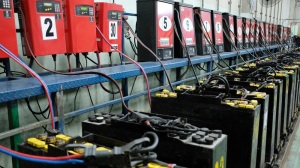Complete Powerpoint slide presentation for forklift instructors. Ready made training course
forklift charging station power requirements explained
 Whether you’re running one electric forklift truck or an entire forklift fleet, your warehouse needs a designated forklift charging station. Discover how to make your charging room practical, compliant, and safe.
Whether you’re running one electric forklift truck or an entire forklift fleet, your warehouse needs a designated forklift charging station. Discover how to make your charging room practical, compliant, and safe.
Electric forklift trucks are very popular in material handling operations. It’s easy to see why: they have impressive economic and environmental benefits for businesses, including increased fuel efficiency, lower fuel costs, and reduced CO2 emissions.
However, for companies keen to implement this technology in their warehouses, considerations must be made to ensure they have a dedicated battery charging area fitted with the necessary safety features to meet forklift charging station power requirements.
Unsure about what should be included? Discover the safety features your battery charging station needs here.
1. Charging points must be fitted correctly
Your first port of call should be ensuring chargers are mounted correctly for complete accessibility. Locate an accessible area with a wall against which the chargers can be mounted. For safety and compliance reasons, all chargers should also be fitted with emergency stop breakers to ensure the flow of electricity can be stopped in an emergency.
Another key area to look out for is hanging wires as this presents a significant tripping hazard for operators. This safety risk is easy to mitigate by ensuring chargers are mounted at the appropriate height and wires are no longer than a metre in length.
The final point to consider when charging multiple units is to leave at least a one-metre gap between each forklift truck. This ensures that the vehicle is always accessible to operators.
2. Acid resistant flooring is essential for preventing warehouse damage
Rare manufacturing defects or damage to the cell can cause batteries to leak, resulting in damage to the immediate area. For this reason, it’s important to install acid-resistant flooring.
In addition to protecting your warehouse environment, specialist flooring ensures that leaks are more easily cleaned up, saving you time and money in the long run.
3. Safety equipment must be easily accessible at all times
The true cost of forklift accidents can be fatal. Basic safety equipment should be readily available in your charging station area, alongside more specialist equipment to protect your workforce in the event of an incident such as an accidental acid spill.
Your charging station should be fitted with a fire extinguisher suitable for use on electrical fires. When considering the safety and financial implications of a warehouse fire, installing a fire extinguisher is a small price to pay to protect the long-term wellbeing of your workforce and operation.
Additional but equally necessary safety equipment should include an emergency shower and eyewash, in case an operator comes into contact with battery acid.
4. Adequate ventilation is crucial in ensuring operator safety
Ventilating your charging area is essential in ensuring operator safety, since charging forklift batteries produces hydrogen gas, which is difficult to detect and extremely dangerous.
To mitigate this, air quality should be frequently monitored to ensure hydrogen levels stay below 2% at all times.
Despite being easy to achieve through building openings and exhaust fans, ventilation is arguably one of the most vital safety features your charging station should have to keep your workforce safe.
5. Future-proof your charging station today to ensure operator safety tomorrow
Electric forklift trucks come with a range of operational, environmental, and cost-saving benefits, including considerably lower CO2 emissions than their diesel counterparts. However, for businesses adopting an increasing number of electric trucks, it’s vital to ensure you a) have the required forklift charging stations in place to meet demand and b) that your charging facilities comply with safety and operational standards.
Implementing the above practical tips will ensure your warehouse charging station is a safer and more efficient environment for the operators using it every day.
This article was originally written by TCM and Anglised by me
Disclaimer. The legislative information contained on this web site is my interpretation of the law based on many years in the health and safety business. A definitive interpretation can only be given by the courts. I will therefore not be held responsible for any accident/incident/prosecution arising as a consequence of anyone using any information obtained from this web site.